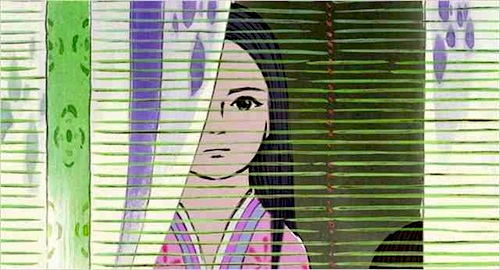By Joe Bendel. It is a quite a story of social mobility, especially for Tenth Century Japan. Of course, it is a folktale, but it is considered Japan’s oldest surviving narrative (even predating The Tale of Genji). It inspired adaptations from the likes of Kon Ichikawa, but the lush, budgets-be-damned Studio Ghibli treatment may very well come to be recognized as the definitive big screen production of “The Tale of the Bamboo Cutter.” Representing most likely the penultimate release from the storied studio, Isao Takahata’s The Tale of Princess Kaguya opens this Friday in New York at the IFC Center.
One day, Okina, the stout-hearted bamboo cutter, discovered a miniature princess dressed up in regal finery within one of the shoots he had chopped. Taking her home to his wife Ona, the precious princess transforms into the infant they never had. Miraculously, Ona discovers she is still able to nurse the baby they presume to be heaven-sent. “Princess,” as Okina simply calls her, grows up quickly, soon maturing to the level of the nearest children, who affectionately call her “Bamboo.” She loves the simple pleasures of nature and the company of her rambunctious friends. However, Okina believes his faith in her royal destiny is vindicated when he discovers miraculous caches of gold and silk in yet more fateful bamboo shoots.
Okina uses the gold to build a palatial estate in the capitol, buying his way into elite society. Unfortunately, his worldly ideas of happiness are at odds with her more spiritual conceptions. Despite her love for her adopted parents, Princes Kaguya, as she has been officially dubbed, consistently foils his plans to codify her royal status. Eventually, her ensuing unhappiness will have cosmic repercussions.
It is hard to imagine another animated film prominently featuring a princess that is as likely to frustrate young Frozen fans as Princess K surely will. It is an extraordinarily elegant, visually arresting film, but it is also exquisitely tragic, unabashedly literate, and rich with symbolic texture. It additionally represents some of accomplished Japanese film composer Joe Hisaishi’s most distinctive work, but the entire film is probably too sophisticated, in an almost rarified way, to garner much Oscar love in any category.

Regardless, Princess K is a stunning example that animation can truly be a work of art. Takahata’s hand-drawn animation evokes the austere beauty of traditional Japanese watercolor, but the resolution and color palate shift to reflect Kaguya’s emotional state. Dramatically, it is a disciplined slow-builder, earning every tear it jerks down the stretch, fair and square.
Frankly, it is easy to get stuck on the ethereal beauty of Princess K, but there is an awful lot going on beneath the surface. Kaguya represents a refreshingly independent-minded and psychologically complex princess, particularly during the Heian era. Arguably, it is also the first science fiction story ever, taking into account Kaguya’s full origin, which is only revealed late in the third act. It is easily the best new animated film of the year, unless you also count Hayao Miyazaki’s Studio Ghibli release, The Wind Rises (which had a brief Oscar qualifying run late last year). Very highly recommended for mainstream audiences as well as animation enthusiasts, The Tale of Princess Kaguya opens this Friday (10/17) at the IFC Center, with special preview screenings scheduled for tonight and tomorrow night.
LFM GRADE: A
Posted on October 15th, 2014 at 9:10pm.